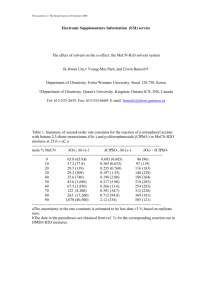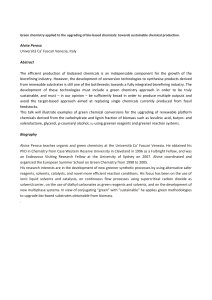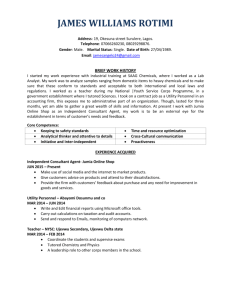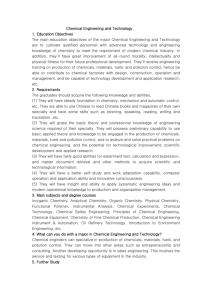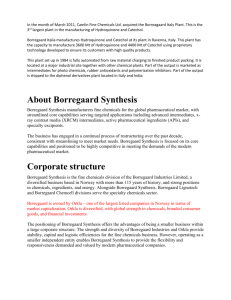Abstracts-15-Dec-2011 - RSC Speciality Chemicals Sector
advertisement
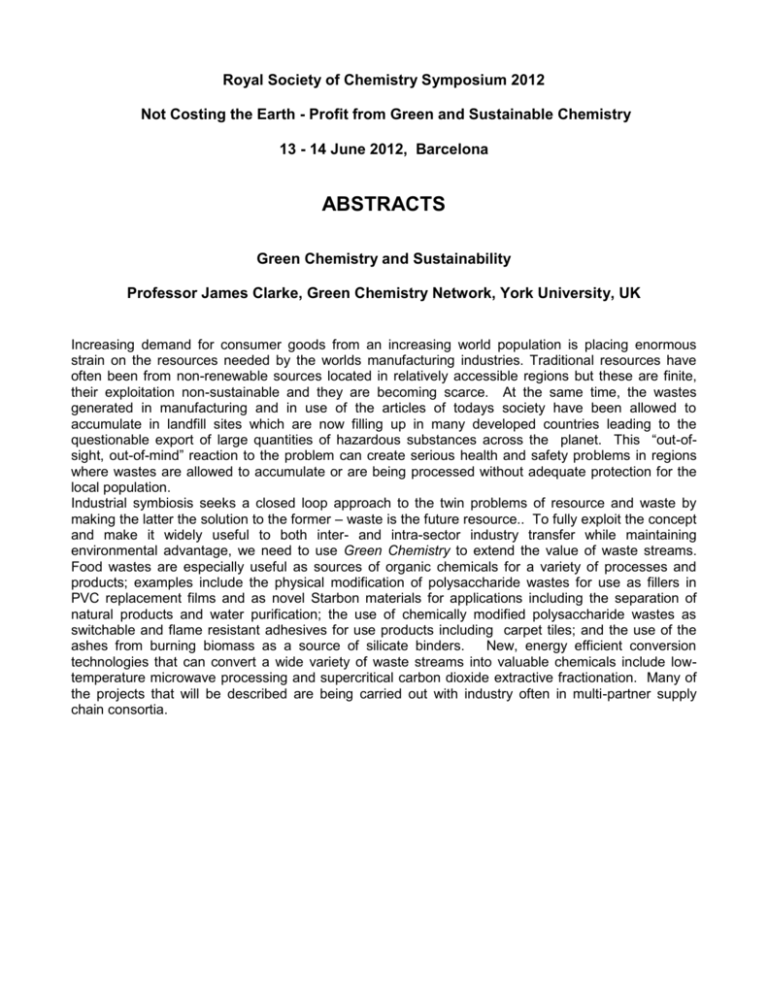
Royal Society of Chemistry Symposium 2012 Not Costing the Earth - Profit from Green and Sustainable Chemistry 13 - 14 June 2012, Barcelona ABSTRACTS Green Chemistry and Sustainability Professor James Clarke, Green Chemistry Network, York University, UK Increasing demand for consumer goods from an increasing world population is placing enormous strain on the resources needed by the worlds manufacturing industries. Traditional resources have often been from non-renewable sources located in relatively accessible regions but these are finite, their exploitation non-sustainable and they are becoming scarce. At the same time, the wastes generated in manufacturing and in use of the articles of todays society have been allowed to accumulate in landfill sites which are now filling up in many developed countries leading to the questionable export of large quantities of hazardous substances across the planet. This “out-ofsight, out-of-mind” reaction to the problem can create serious health and safety problems in regions where wastes are allowed to accumulate or are being processed without adequate protection for the local population. Industrial symbiosis seeks a closed loop approach to the twin problems of resource and waste by making the latter the solution to the former – waste is the future resource.. To fully exploit the concept and make it widely useful to both inter- and intra-sector industry transfer while maintaining environmental advantage, we need to use Green Chemistry to extend the value of waste streams. Food wastes are especially useful as sources of organic chemicals for a variety of processes and products; examples include the physical modification of polysaccharide wastes for use as fillers in PVC replacement films and as novel Starbon materials for applications including the separation of natural products and water purification; the use of chemically modified polysaccharide wastes as switchable and flame resistant adhesives for use products including carpet tiles; and the use of the ashes from burning biomass as a source of silicate binders. New, energy efficient conversion technologies that can convert a wide variety of waste streams into valuable chemicals include lowtemperature microwave processing and supercritical carbon dioxide extractive fractionation. Many of the projects that will be described are being carried out with industry often in multi-partner supply chain consortia. Biomass Based Refinery at Borregaard: Past. Present and Future Klaus Neumann, Borregaard, Norway Borregaard is operating one of the most advanced biorefinery systems within the present biomass based industries; bioethanol from lignocellulosics since 1938, the only producer of vanillin from wood, specialty cellulose and lignin performance chemicals as well as fine chemicals. The biorefinery history of Borregaard will shortly be presented as a background case for new biorefineries as well as development programs within new application areas. As far s new developments an outlook will be provided both on new technologies and product opportunities. Borregaard has for several years directed substantial resources into developing a new and efficient pretreatment process for lignocellulosics. This pretreatment process was initially developed for production of biochemicals, but Borregaard also sees a greater potential in this pretreatment process than the company can explore on its own and is therefore seeking cooperation with partners who want to build on the sugar platform. *********************************************************************************** Mike Butler, Unilever, UK Title and abstract awaited. ECO-nomics behind Biobased Chemicals Gerald van Engelen and Robert Nolles, Cosun Biobased Products, The Netherlands A wide spread and growing concern about the condition of our planet and the future supply and costs of food, energy and other raw materials is driving the development of the biobased economy. In the nearby future biobased (renewable) resources will on large scale replace fossil based resources for the production of not just energy, but especially chemicals and materials. This will lead to a major shift in the industrial landscape and will affect industrial sectors like the chemical industry and the agro-food industry. Royal Cosun, a Dutch agro-food company, is actively anticipating on the upcoming biobased economy with a consistent strategy and the development of innovative biobased chemicals and materials from renewable, vegetable resources. Under development are new furan polymers, biobased plasticizers and micro/nano cellulose fibers for composite materials. Currently, commercially available are derivatives based on inulin such carboxymethyl inulin and cationic inulin which are applied in various industries (e.g. detergents, water treatment, drinking water production and oil exploration). Besides the good functionality, these products offer an excellent ecotox profile. Developing Sustainable Technologies Damian Kelly, Croda, UK Croda is a global speciality chemical manufacturing business that develops new sustainable technologies for personal care, health care, crop care, home care, lubricants and other industrial niche markets. Croda is driven by innovation with a focus on selling effects and not chemicals. Croda has a successful history of adding value to naturally derived raw materials by purification, separation and derivatisation. Croda converts natural feedstocks such as rapeseed, woolgrease, fish oil, wheat, soya, milk, etc into speciality chemicals which deliver effects which are important to consumers. Croda’s speciality chemical range comprises of proteins, lipids, peptides, esters and a wide range of anionic, cationic and non-ionic surfactants that all offer various effects depending on the intended application. All Croda’s speciality products undergo rigorous claims substantiation tests as well as environmental profiling so that we are confident in the performance that is being offered. Croda is evidence that green chemistry can offer cost-effective, performance driven speciality chemicals. Sustainable Production of Advanced Intermediates and API's Using Bio- and Homogeneous Catalysis André de Vries, DSM Innovative Synthesis BV, The Netherlands The production of pharmaceuticals and other life science molecules leads to a considerable amount of waste compared to commodity chemicals. As there is cost associated with waste disposal, low yields and energy usage, minimizing these factors can make the process cheaper and also greener. Both chemocatalysis and biocatalysis are excellent technologies to improve these factors. At DSM Innovative Synthesis a synthetic design starts with an ideation meeting where all relevant competence experts from homogeneous catalysis, biocatalysis, organic chemistry and process intensification are present to come up with the best route in terms of cost and sustainability. Examples of such synthetic design exercises (route scouting) will be disclosed, e.g. the improved process for (S)-2,3-dihydro-1H-indole-2-carboxylic acid (see scheme), a key intermediate for ACEinhibitors such as Inolapril and Perinodpril, that are used for treatment of hypertension. The original manufacturing process involved a Fischer-Indole synthesis followed by classical resolution, a total of 7 steps including racemisation and recycling of the undesired enantiomer. The new route consists of 2 steps: a Phenyl Ammonia Lyase (PAL) catalysed addition of ammonia to 2-halogen cinnamic acid derivative, followed by a copper catalysed intramolecular C-N bond formation (overall yield > 80%, e.e. >99%). A detailed LCA reveals a 80% reduction. Biocatalysis: The Way Out of Resource Dissipation and Environmental Pollution Pascal Duenkelmann, evocatal GmbH, Germany The increasing scarcity of raw materials and the drastically rising expenses we have to cover due to the impact of the environmental pollution are only two factors that imposingly point to the urgent need for resource-saving and sustainable practices. Also the chemical and pharmaceutical industry is concerned by these matters and many attempts are made to counter these. Direct attempts that are focused on the reduction of the raw materials consumption as well as indirect efforts focused on the decrease of the energy required for the production processes are investigated here together with new strategies centering on completely different synthetic routes. All these approaches can efficiently be addressed by applying biocatalysis, which means the use of enzymes or whole cells for chemical conversions. In doing so the reduction of limited, expensive and in many cases toxic resources is facilitated. E.g. the use of organic solvents can be decreased noteworthy, the use of heavy metals can be circumvented and the atom economy can be drastically increased. Also, the application of the technically not demanding biocatalytic processes allows the reduction of energy resources due to the mild reaction conditions. Furthermore, strategies mimicking biological pathways can open access to important building blocks and intermediates starting from completely new substrates. In this context it has to be considered that biological, biotechnological or biocatalytic processes are not per se sustainable and/or environmentally friendly. Though nature as the role model for such conversions offers an unlimited range of theoretically feasible approaches most of them do not meet the needs regarding sustainability as well as economy. Usually the biocatalyst needs to be adapted to the non-natural reaction conditions. evocatal´s technologies enable the targeted optimization of enzymes according to the synthetic needs. Expression technologies that allow the resource and cost efficient production of enzymes on ton scale are among these technologies as well as technologies that are focused on the tuning of the biocatalysts regarding stability, selectivity, etc. The effectiveness of this concept could already be proven by evocatal for a broad variety of enzyme classes resulting in multiple production processes for valuable chemistry. Enablers of the Successful Scale Up of Industrial Biotechnology Processes Manjusha Thorpe & Tom Ridgman, Cambridge University, UK The development of innovative manufacturing processes is becoming increasingly important in the specialty chemicals industry. This shift towards new technologies is, to a significant extent, being driven by an escalating concern for global climate change and diminishing reserves of non-renewable resources. In many cases the new technologies involve the replacement of conventional chemical processes with more sustainable industrial biotechnology processes, or in other words, processes based on green chemistry. However, the scale up of industrial biotechnology processes from laboratory to commercial production poses significant challenges. Research has been conducted to elucidate enablers of the successful scale up of industrial biotechnology processes in the specialty chemical industry. The research has lead to the development of a framework describing the factors influencing successful scale up and the relationships between these factors. The data suggest that there is a different set of parameters affecting the scale up of industrial biotechnology processes compared with conventional processes. In particular, the research highlights the types of experience, knowledge and skills that are important in scale up. Another key finding is a clearer articulation of the paradox that exists between the specialty chemical industry’s interest is pursuing continuous processing technologies and the preference for batch processing, which prevails in a number of green chemistry applications. Additional work is underway to further characterise enablers of successful scale up. In particular, guidelines and tools are being developed to promote the commercialisation of sustainable industrial biotechnology processes within the specialty chemicals industry. New Business through Resource Efficiency Mike Pitts, Chemistry Innovation Ltd, Knowledge Transfer Network, UK This talk will cover the drivers behind the need for more resource efficient business models starting with the limits on primary sources of raw materials. The key issue for resource efficiency is to provide 9 billion people with a high quality of life using the resources of one planet. Chemistry will be key to this. The presentation will cover how chemistry can enable new business models and how the principles of sustainable design can be applied to innovating new products. Processes and services from the chemistry-using industry. Cradle to Cradle: Designing with Nutrients, Creating Abundance Ignasi Cubiña, Eco Intelligent Growth, Spain We’re finally tapping the limits of nature because we’re imparting its dynamics, simply put. We don’t have a population problem, we have a problem with our current business growth and prosperity model, so it’s time to review and remake things from scratch. We don’t have an energy problem either, but a materials problem (and yes, information is material too). If we want to design a world for 10 billion people (this is what politics should be all about), we need to ask ourselves the right questions. Assessing the life cycle of products, materials and services is a good starting point (inventory) but it doesn’t pose the right questions. Resource management (water and energy alike), scarcity of raw materials, celebration of diversity and a product of service economy as an alternative to our current Cradle to Gate industrial model, is what the Cradle to Cradle approach is addressing. We need to think systemically, and chemists can do so by designing from the molecule to the region. There’s no such thing as a bad material but a bad use/design with such a material (e.g. why are we promoting the replacement of lead by bismuth in computers). We need to define a roadmap based on progress and a positive agenda. Let’s start with values, principles and criteria, and end up with metrics, but not the other – preeminent – way around. Let’s talk about a strategy of hope, instead of a de facto strategy of tragedy. The industry – all the industries - has to be part of the solution, instead of part of the problem. Chemists are fostering science, so we need to set up the scientific fundamentals backing a strong business proposal. It’s not about eco-friendliness and eco-efficiency, it’s about eco-effectiveness and the celebration of abundance in the Planet. The Cradle to Cradle vision and design framework aspires to be a cornerstone for the new era of positive footprint products and services, truly Good products not just Less Bad. We have the science and the demand – yes, clients want good not bad - so we just need to connect the dots. There’s a lot of transversal knowledge in this industry, arguably the best educated industry in the world, but we need a Plan, an evolving and evolutionary one by the way. We can celebrate service and quality with clients, people and the industry, in harmony with Nature and contributing to the prosperity of all communities, here and there, today and tomorrow, focusing on users and clients rather than consumers. The case studies presented here are true innovations undergoing a deep transformation for themselves – first – and most importantly for all their stakeholders. While designing through a C2C framework, we’re aligning the best ideas, people, company and INTENTIONS of our world. We’re not here to save the planet, but to help companies to do so. If not us, who? If not here, where? If not now, when?” Sustainable Solvents: Products and Process Innovations Thierry Vidal, Rhodia Recherches et Technologies SAS, France Due to increasing environmental and regulatory concerns, there is a need to find alternative solvents that are environmentally friendly while continuing to deliver traditional solvent performance. A new diester solvent Rhodiasolv® IRIS combining good solvency properties and eco-friendly profile will be presented. This solution is synthesised by a sustainable process using two original catalytic steps and valorising a by-product of the polyamide 6,6 chain. Rhodiasolv® IRIS and its formulated forms may then be an answer to the global need for sustainability in various areas. A new safe polar solvent based on tertiary amidoester compound will be presented. Rhodiasolv® Polarclean exhibits outstanding safety profile, is non toxic for the environment and very effective in dissolving many agrochemical active ingredients. Rhodiasolv® Polarclean may then be an answer to the global need for sustainability in agro formulations. Finally, Augeo solvents range based on glycerin, a byproduct of biodiesel production, will be presented. A set of new products based on glycerin, low cost renewable source, and with excellent HSE properties. Augeo SL 191 is the first product that has both characteristics, representing a sustainable alternative to replace ether ester glycols, since there is an increased concern about the toxicological effects of some ethylene oxide–based glycol ether esters. Green Applications of Acetal Solvents Todd Coleman, FutureFuel Chemical Company, USA Solvents have been defined as “green” by a myriad of definitions. One widespread definition of a green solvent depends on the ability of the solvent to replace an existing solvent that may be perceived as toxic, hazardous, or environmentally damaging. A second common definition of a green solvent is based on the source of the raw materials used to manufacture the solvent. Yet a third definition for a green solvent is based on the ability to recover and recycle the solvent in a processing application. An existing family of commercially available acetal solvents meets several of these definitions of a green solvent. For example, 1) dimethoxymethane can be used as a replacement for chlorinated solvents in cleaning products; 2) dibutoxymethane is being evaluated as a solvent to replace perchloroethylene in dry cleaning applications, and 3) glycerol formal is used as a solvent in animal injectibles, and has a large potental to be derivatized for applications in coatings, water dispersants, and personal care products. Additionally, diethoxymethane has been found to be a useful solvent in organometallic and phase-transfer catalyzed reactions and may be used to produce a wide variety of fine chemical, agricultural, and pharma intermediates and actives. Detailed examples of applications and potential applications of the above listed solvents will be described.

